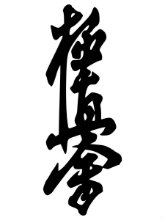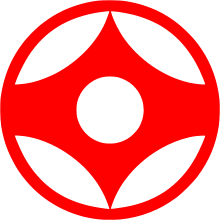Kyokushin (極真) is a style of full contact karate, founded in 1964 by Korean-Japanese Masutatsu Oyama (大山倍達 Ōyama Masutatsu), who had been developing it since the early 1950’s. “Kyokushinkaikan” is comprised of four Japanese words:
- Kyoku: Ultimate
- Shin: Reality or truth from within
- Kai: To meet, join or associate
- Kan: Temple, sanctuary, school
 The kanji lettering used to spell Kyokushinkai can be translated as “society for the ultimate truth,” which reflects founder Masutatsu Oyama’s belief that traditional karateka were becoming soft, missing the forceful combative nature of the true art. Kyokushin’s philosophy centers on discipline and self-improvement, which Masutatsu Oyama believed could be further honed through rigorous training and full-contact sparring. Kyokushin karate-ka believe this contact is necessary in order to fully appreciate the resiliency of the human body and spirit and to prepare for any serious confrontation.
The kanji lettering used to spell Kyokushinkai can be translated as “society for the ultimate truth,” which reflects founder Masutatsu Oyama’s belief that traditional karateka were becoming soft, missing the forceful combative nature of the true art. Kyokushin’s philosophy centers on discipline and self-improvement, which Masutatsu Oyama believed could be further honed through rigorous training and full-contact sparring. Kyokushin karate-ka believe this contact is necessary in order to fully appreciate the resiliency of the human body and spirit and to prepare for any serious confrontation.
The Spirit of Kyokushin emanates from the Budo axiom,
“One thousand days of training completes a beginner. Ten thousand days of training begins the mastery of the art.”
It was this training, the knockdown competitions and Mas Oyama’s incredible feats of strength and endurance that caused Kyokushin to be known as “The strongest karate.” Kyokushin was cited by the Guinness book of World Records as one of the five major schools of Karate in Japan, and at one time Kyokushin was cited as the largest organization under one master.
 The internationally recognized symbol of Kyokushin karate is the “Kanku,” which Oyama designed with his wife Chiyako, who was an artist. Oyama got the inspiration while practicing the Kanku Dai kata. In this form, the hands are raised to the sky with the fingers touching. The logo interprets the fingers as the points implying the peaks, representing the wrists as the wide sections, signifying power. The center represents infinity and the circle that encloses the parts, continuity and circular motion. The main circle in the middle is surrounded by four other partially invisible circles and the final one encompassing all others. The six circles are representative of the comradeship of these continents which Kyokushin bridges and unites. This mark is used as a collective mark for IKO Kyokushinkaikan.
The internationally recognized symbol of Kyokushin karate is the “Kanku,” which Oyama designed with his wife Chiyako, who was an artist. Oyama got the inspiration while practicing the Kanku Dai kata. In this form, the hands are raised to the sky with the fingers touching. The logo interprets the fingers as the points implying the peaks, representing the wrists as the wide sections, signifying power. The center represents infinity and the circle that encloses the parts, continuity and circular motion. The main circle in the middle is surrounded by four other partially invisible circles and the final one encompassing all others. The six circles are representative of the comradeship of these continents which Kyokushin bridges and unites. This mark is used as a collective mark for IKO Kyokushinkaikan.
“Keep one’s head low (modest), eyes high (ambitious), mouth shut (silent), base yourself on filial piety and benefit others.” ~ Kyoskushin ideal by Sosai Mas Oyama
Sosai Masu Oyama often said that the difference between sports and the Budo Way is the path of self-discipline. Sports can always be associated with a game in some form or another where people compete for leisure, money, or fame. The Budo way is never these since it was developed from harsh-living situations where one must fight for their life in the midst of human suffering and pain – this can either be of the mental or physical kind. The Budo Way is this challenge in life itself.
Kyokushin training consists of three main elements: technique, forms, and sparring. These are sometimes referred to as the three “K’s” after the Japanese words for them: kihon (basics), kata (forms), and kumite (sparring). Kata is a form of ritualized self-training in which patterned or memorized movements are done in order to practice a form of combat maneuvering.
Today, there are over 12 million Kyokushin karateka globally, spread across 130 countries making it one of the largest martial arts organization in the world.
Osu!